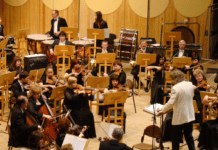The construction of an orchestra is a complex project, with several people taking leading roles. An orchestra is made up of several parts that are under the leadership of the conductor. The conductor may be leading the orchestra, but the orchestra leader is often the principal violinist who acts as the de facto leader of an orchestra. The conductor makes no sound, meaning the principal violinist leads the orchestra through his playing. In modern orchestra, the symphony leader is a sought-after position and includes several leaders of different sections.
The Conductor
There are several reasons why the conductor is and is not the leader of the orchestra. They are given the role of interpreting the music of the composer and making sure the orchestra remains in time and correctly interprets the music. The conductor is the most visible part of the orchestra when playing in a traditional concert hall because of their position on a raised pedestal. When a conductor is directing the music of a composer, they try to physically express the feeling of the music to their players. There are several ways the conductor directs the music of his players, including the use of the baton and their bodies.
The Principal Violinist
Famous orchestra leaders can use different instruments, including the violin, flute, and trumpet. The most popular orchestra leader in the pit is the principal violinist, sometimes called the first violin. The position of the first violin is a popular one because of the number of violin solos found in classical music. Each season, an orchestra will hold auditions for the role of the principal violin.
The principal violin is the leader of the orchestra for several reasons. The first of which is their great skill at performing as part of the group and on their own in a solo. The use of violin solos continues to expand and requires the highest level of skill and musicianship. When they audition for the role of principal violin, a musician must prove they have the ability to unite their department and the orchestra as a whole. The conductor of an orchestra does not make a sound, which means the playing of the principal violin is the guide for most of the orchestra regarding tempo and rhythm.
Several Departments
The size of orchestras has grown over the years to include several players who are known as symphony leaders. These players are chosen from each department and given the responsibility of keeping their department performing at a high level for the good of the orchestra.
Some orchestras appoint a leader for every section of their group. In larger orchestras where a group has several players of the same instrument, a group of leaders is chosen. The number of instruments and players within an orchestra directly links to the list of leaders they appoint.
The Most Famous Orchestra Leaders
When thinking of the world’s most famous orchestra leaders, the names at the top of a list include conductors. The importance of a leader of an orchestra means they can hold these positions for several years. Included in any list of the leaders of orchestras around the world are:
- Adolf Herseth
- Sabine Meyer
- Josef Gingold
- James Galway
The list of the leaders of different orchestras takes in several from across the 20th-century, who have become household names. The list shows there does not need to be a principal violin as the leader of a group of musicians, with flutists and clarinet players making an appearance.
James Galway
Galway became a global sensation in the 1970s and 80s for his exquisite flute playing. The flutist was born to a poor family of dockworkers on the troubled streets of Belfast in Northern Ireland. Galway went on to appear with several esteemed symphony orchestras. After turning don the Berlin Symphony, the conductor Herbert von Karajan begged James Galway to try a position with them for six months. The man with the golden flute stayed for six years and made his home in the German capital.
Adolf Herseth
Adolf Herseth enjoyed a position of unmatched respect at the Chicago Symphony. Playing with the orchestra for more than half a century, the orchestra leader called Adolf Herseth became one of the most respected players in the world. Herseth played more than 50 solos in Chicago but felt he was most important as the glue holding the group of musicians together through his trumpet.
Josef Gingold
The orchestra leader called Josef Gingold is known for his work as a concertmaster for several symphonies. The violinist was popular among his contemporaries after starting his career in the U.S. as a member of the NBC Symphony Orchestra. Over a career lasting more than half a century, the violinist made appearances in Detroit and Chicago as the principal violinist with both orchestras.
Sabine Meyer
The clarinet player made an impact as one of the leading members of the classical music sector. In her early career, her time with the Berlin Symphony caused controversy over her departure after only six months. A probationary period came to an end when her fellow members voted for her to leave, largely because of her gender. Meyer remains one of the most popular clarinet players in the world and works with several symphonies.
Table of Contents






